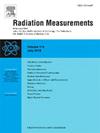The influence of beta-irradiation dose and stimulation temperature on luminescence optically stimulated from rose quartz using linear-modulation
IF 2.2
3区 物理与天体物理
Q2 NUCLEAR SCIENCE & TECHNOLOGY
引用次数: 0
Abstract
We present linearly modulated optically stimulated luminescence (LM-OSL) of rose quartz. The luminescence was stimulated using 470 nm blue light. The time-dependent plot of the luminescence intensity shows two distinct peaks. Analysis of this LM-OSL curve by deconvolution shows that it consists of at least five components. A number of factors related to these components have been considered. In particular, the effect of beta dose on kinetic parameters such as the optical stimulation probability and the photoionisation cross-section are reported. The thermoluminescence (TL) glow curve measured at 1 °C/s after irradiation to 10 Gy shows a high intensity peak at 76 °C and weaker-intensity ones at 118, 192, 300 and 412 °C. The primary peak at 76 °C is affected by thermal quenching. The value of the activation energy for thermal quenching as evaluated using LM-OSL and TL are consistent suggesting a common recombination center for the LM-OSL and TL of the primary peak.
用线性调制法研究辐照剂量和激发温度对玫瑰石英光激发发光的影响
我们提出了玫瑰石英的线性调制光激发发光(LM-OSL)。用470nm蓝光刺激发光。发光强度随时间变化的图有两个明显的峰。对该LM-OSL曲线进行反褶积分析表明,该曲线至少由5个分量组成。已经考虑了与这些组成部分有关的许多因素。特别地,报告了β剂量对动力学参数如光刺激概率和光电离截面的影响。在1°C/s下测得的热释光(TL)发光曲线显示,在76°C处有高强峰,在118、192、300和412°C处有弱强峰。76℃时的主峰受到热淬火的影响。用LM-OSL和TL计算的热猝灭活化能值一致,表明主峰的LM-OSL和TL有一个共同的复合中心。
本文章由计算机程序翻译,如有差异,请以英文原文为准。
求助全文
约1分钟内获得全文
求助全文
来源期刊

Radiation Measurements
工程技术-核科学技术
CiteScore
4.10
自引率
20.00%
发文量
116
审稿时长
48 days
期刊介绍:
The journal seeks to publish papers that present advances in the following areas: spontaneous and stimulated luminescence (including scintillating materials, thermoluminescence, and optically stimulated luminescence); electron spin resonance of natural and synthetic materials; the physics, design and performance of radiation measurements (including computational modelling such as electronic transport simulations); the novel basic aspects of radiation measurement in medical physics. Studies of energy-transfer phenomena, track physics and microdosimetry are also of interest to the journal.
Applications relevant to the journal, particularly where they present novel detection techniques, novel analytical approaches or novel materials, include: personal dosimetry (including dosimetric quantities, active/electronic and passive monitoring techniques for photon, neutron and charged-particle exposures); environmental dosimetry (including methodological advances and predictive models related to radon, but generally excluding local survey results of radon where the main aim is to establish the radiation risk to populations); cosmic and high-energy radiation measurements (including dosimetry, space radiation effects, and single event upsets); dosimetry-based archaeological and Quaternary dating; dosimetry-based approaches to thermochronometry; accident and retrospective dosimetry (including activation detectors), and dosimetry and measurements related to medical applications.
 求助内容:
求助内容: 应助结果提醒方式:
应助结果提醒方式:


